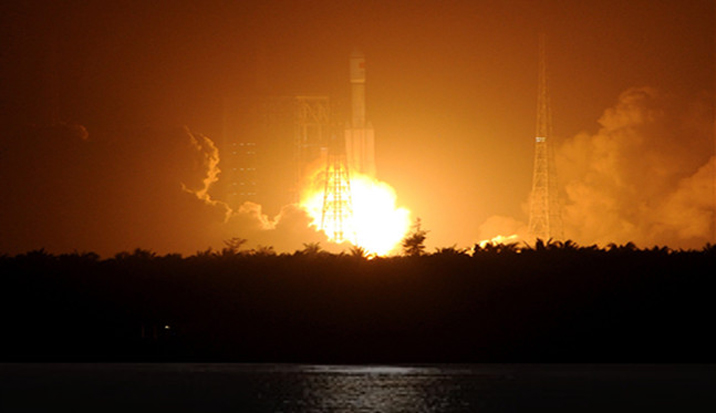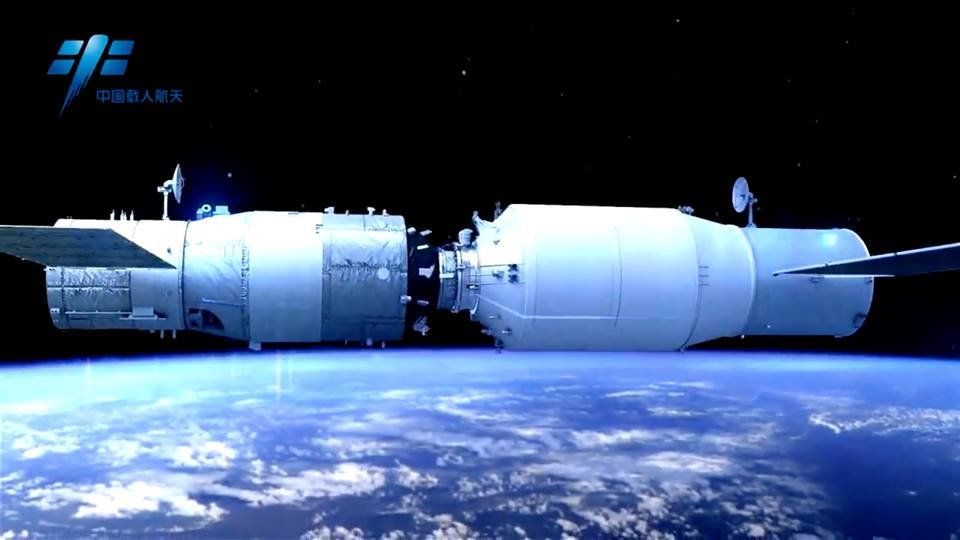
China Launches Its First Space Cargo Ship Into Orbit

China's bid to establish a permanently crewed space station got a boost today (April 20) with the launch of the country's first cargo supply spacecraft: the Tianzhou-1.
The uncrewed Tianzhou-1 cargo resupply spacecraft launched into orbit atop a Long March 7 Y2 booster from the Wenchang Satellite Launch Center in the southern island province of Hainan. Liftoff occurred at 7:41 p.m. local time (7:41 a.m. EDT/1141 GMT) at the spaceport.
Space program officials in China declared mission success shortly after the rocket launched and the vehicle deployed its solar panels. Tianzhou-1 is now on track to dock with the Tiangong-2 space laboratory, or "Heavenly Palace 2," where two astronauts spent a month last October in China's longest-ever crewed spaceflight. That crewed mission, called Shenzhou-11,lasted 33 days.
A big test for China
Tianzhou-1 is a vital element in China's planned space station,which is set to be pieced together in the 2020s. The Tianzhou-1 spacecraft is 34.7 feet (10.6 meters) long and nearly 11 feet (3.35 m) in diameter at its widest point. It weighs 9.4 tons (8.6 metric tons) on its own and can carry more than 6.6 tons (6 metric tons) of supplies, according to a China Manned Space Agency statement.
The supply ship is expected to link up with the now-orbiting, but currently unoccupied Tiangong-2 space lab. A major objective of the mission is to perform refueling tests of the space lab, a prelude to China maintaining a larger space complex in the near-future, according to China Manned Space Agency officials. [China's First Space Station in Pictures]
After entering orbit, according to CCTV-Plus interviews with Chinese space officials, Tianzhou-1 is slated to conduct a first docking with Tiangong-2 in a few days. The two spacecraft will then have a two-month in-orbit flight to test the liquid-propellant refueling as well as the cargo spaceship's control of the combined vehicles, CMSA officials said.
The two spacecraft will also fly separately for three months, during which time the cargo spaceship will complete its own space science experiments. Then the two will have the third docking to test the automatic fast-docking technology, a test to complete the docking within 6 hours.
Breaking space news, the latest updates on rocket launches, skywatching events and more!
Extensive ground testing
According to Chinese space authorities, there have been more than 600 ground tests that demonstrated Tianzhou-1/Tiangong-2 docking hardware.
"A space station has two docking ports, forward and backward," said Bai Mingsheng, chief designer of the Tianzhou-1 cargo ship at the China Academy of Space Technology, in a CCTV-Plus interview. "So a cargo spacecraft must be able to dock with the station from both directions. This time, Tianzhou-1 will separate from Tiangong-2's backward port and then fly around it to dock from the forward port to examine the docking ability. This is the primary mission of the combination."
"These are new experiments," Bai said in the interview. "A shorter docking time for manned spaceships is of great significance as it will make astronauts more comfortable."
For CGTN video of the Tianzhou-1 liftoff, go to:
http://news.cgtn.com/news/3d41544f30557a4d/share_p.html
For a CCTV-Plus video of the liftoff, go to:
http://pv.news.cctvplus.com/2017/0420/8048405_Preview_1285.mp4
Leonard David is author of "Mars: Our Future on the Red Planet," published by National Geographic. The book is a companion to the National Geographic Channel series "Mars." A longtime writer for Space.com, David has been reporting on the space industry for more than five decades. Follow us @Spacedotcom, Facebook or Google+. This version of this story was posted on Space.com.

Leonard David is an award-winning space journalist who has been reporting on space activities for more than 50 years. Currently writing as Space.com's Space Insider Columnist among his other projects, Leonard has authored numerous books on space exploration, Mars missions and more, with his latest being "Moon Rush: The New Space Race" published in 2019 by National Geographic. He also wrote "Mars: Our Future on the Red Planet" released in 2016 by National Geographic. Leonard has served as a correspondent for SpaceNews, Scientific American and Aerospace America for the AIAA. He has received many awards, including the first Ordway Award for Sustained Excellence in Spaceflight History in 2015 at the AAS Wernher von Braun Memorial Symposium. You can find out Leonard's latest project at his website and on Twitter.


